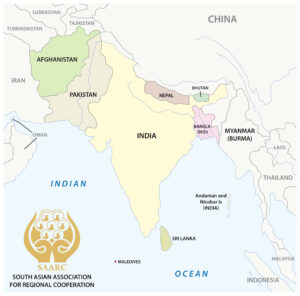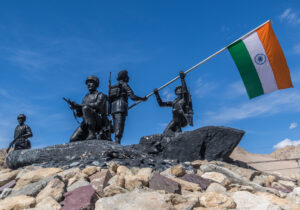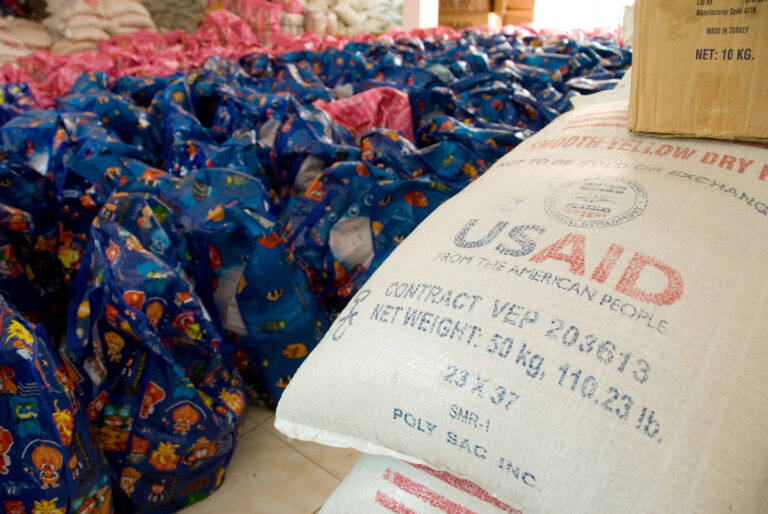The India–Pakistan conflict, rooted in the 1947 Partition and exacerbated by territorial disputes over Kashmir, remains one of the most volatile rivalries in modern geopolitics. The decades have been marked by wars, insurgencies, and military standoffs. Yet while the focus often rests on the two primary actors, China is the third power increasingly shaping the regional balance, not as a distant observer but as a deeply invested stakeholder.
Scholars such as Lowell Dittmer (1981) conceptualize this as a “strategic triangle,” where China plays, leveraging its position between India and Pakistan to maximize strategic gains while avoiding direct entanglement. This triangular relationship complicates the security landscape of South Asia and requires a multidimensional understanding that extends beyond traditional bilateralism.

2019: A Crisis That Redefined the Triangle
In February 2019, tensions between India and Pakistan peaked following a suicide bombing in Pulwama, Kashmir, carried out by the Pakistan-based militant group Jaish-e-Mohammed. India responded with an airstrike in Balakot, targeting what it described as terrorist camps. Pakistan retaliated by downing an Indian jet and capturing the pilot, bringing the nuclear-armed neighbors to the brink of war.
This episode not only redefined Indo-Pakistani dynamics but also exposed the role of external powers in regional crisis management. China, while publicly urging “restraint” on both sides, quietly signaled support for Pakistan at the United Nations and maintained bilateral security cooperation (Wolf, 2019). Such dual messaging exemplifies China’s calibrated diplomacy, which blends public neutrality with strategic preference.
The China–Pakistan Axis: An “All-Weather” Partnership
For decades, China and Pakistan have shared what both governments call an “all-weather” strategic partnership. This alliance spans arms transfers, nuclear collaboration, and economic integration. At its center lies the China–Pakistan Economic Corridor (CPEC), a $60+ billion initiative connecting China’s Xinjiang province to the Arabian Sea via Pakistani territory.
CPEC is often seen as a flagship component of the broader Belt and Road Initiative (BRI), but analysts like Siegfried O. Wolf (2019) argue that it is also a geopolitical project designed to embed China deeper into South Asia’s security architecture. The corridor passes through Gilgit-Baltistan, a region claimed by India, thus placing China squarely during the Kashmir dispute.
From Pakistan’s perspective, CPEC ensures Chinese patronage and economic lifelines. For China, it secures access to maritime routes and deepens its influence in a region critical to its western development strategy. However, Safdar Sial (2014) warns that the corridor also exposes Beijing to regional instability and terrorism, thereby compelling it to engage more proactively in regional security affairs.
China’s Strategic Calculus: Balancing Act or Side-Taking?
China’s approach to South Asia reflects what Michael Yahuda (2011) describes as pragmatic non-interventionism. While publicly neutral during crises, China leans toward Pakistan as a means of counterbalancing India, whose deepening ties with the United States and participation in alliances like the Quad make it a strategic rival.
Moreover, following the 2020 border clash between Chinese and Indian forces in the Galwan Valley, bilateral relations have soured, leading to increased Indian suspicion of China’s regional intentions. India’s view of a “two-front” challenge with China to the north and Pakistan to the west, has intensified calls for defense modernization and strategic autonomy.
Nevertheless, China’s restraint is also informed by economic interests. As Yahuda and Wolf note, the stability of Pakistan is essential for CPEC’s success, and unchecked escalation in Kashmir could threaten years of infrastructure investment.
India’s Perspective: Strategic Encirclement
From New Delhi’s standpoint, China’s infrastructural and military engagement with Pakistan constitutes a form of strategic encirclement. This interpretation is reinforced by the “String of Pearls” theory, as outlined by Jonathan Holslag (2009), which sees China establishing a network of strategic ports and bases throughout the Indian Ocean region.
India has responded by strengthening its partnerships with the United States, Japan, and Australia, deepening involvement in the Quad, and investing in technological self-reliance. The resulting geopolitical rivalry is not limited to South Asia but extends across the Indo-Pacific.
The Human and Diplomatic Toll:
While major powers engage in geopolitical maneuvering, civilians in Kashmir continue to bear the brunt. The region remains heavily militarized, with frequent skirmishes, curfews, and restrictions. Academic work by S. Paul Kapur (2007) on nuclear deterrence in South Asia suggests that the presence of nuclear weapons has not ensured peace, but rather created a space for low-intensity conflicts and proxy violence.
In this context, China could play a more constructive diplomatic role. It possesses significant leverage over Pakistan and could moderate Indian behavior through backchannel diplomacy. However, as Wolf and Yahuda point out, China’s preference remains to preserve the status quo a frozen conflict that secures its strategic interests without incurring diplomatic costs.

Conclusion: Silent Power, Loud Consequences
As the 21st century unfolds, China’s influence in South Asia is growing through roads, ports, pipelines, and selective diplomacy. It is no longer a peripheral actor but a central architect of the regional order. While China avoids overt intervention, its economic investments and diplomatic maneuvers suggest a strategic intent to shape outcomes.
The India–Pakistan rivalry, once viewed through a bilateral lens, must now be understood as part of a trilateral equation. Academic perspectives help illuminate the nuances of this relationship, revealing China not just as a “friend of a friend,” but as a strategic force capable of tilting the balance quietly, but decisively.
By Vittoria Saldutti



